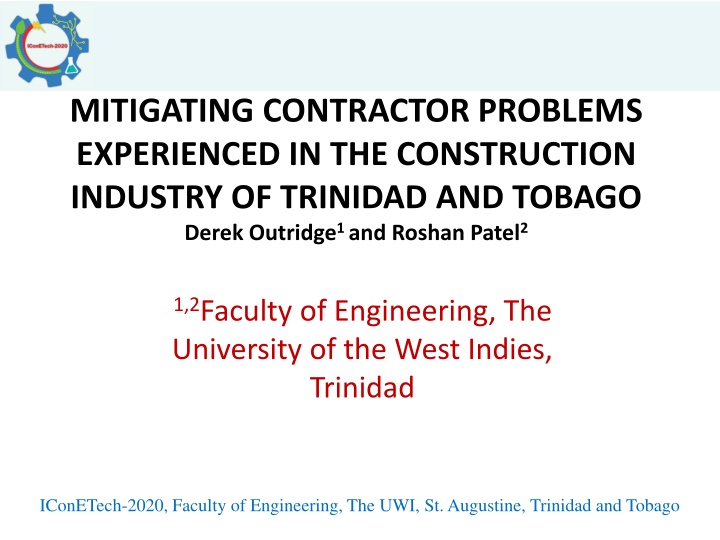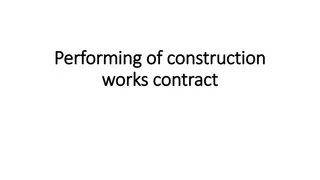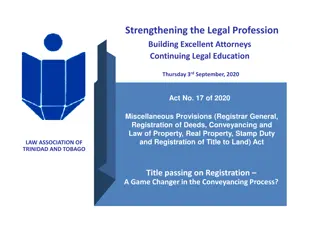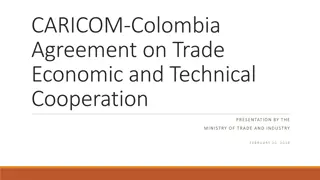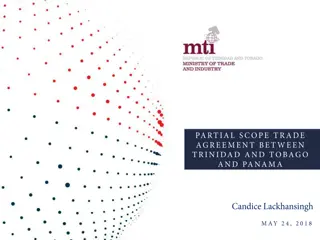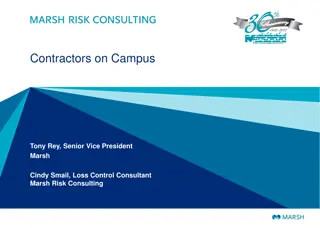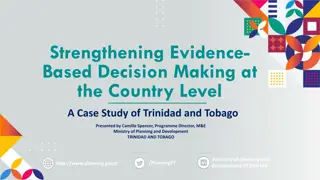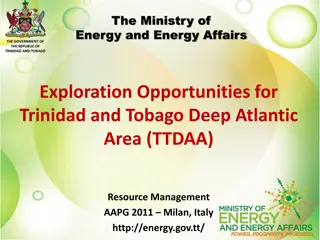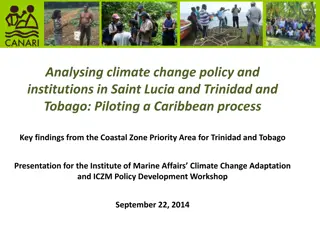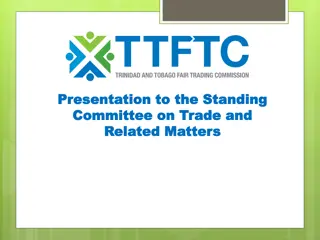Mitigating Contractor Problems in Trinidad and Tobago's Construction Industry
The construction industry of Trinidad and Tobago plays a vital role in national development and economic growth. However, contractors in this industry face various challenges like delayed payments, poor planning, management issues, schedule delays, corruption, and litigation problems. Addressing these issues is crucial to improving overall performance and sustainability in the construction sector.
Download Presentation

Please find below an Image/Link to download the presentation.
The content on the website is provided AS IS for your information and personal use only. It may not be sold, licensed, or shared on other websites without obtaining consent from the author.If you encounter any issues during the download, it is possible that the publisher has removed the file from their server.
You are allowed to download the files provided on this website for personal or commercial use, subject to the condition that they are used lawfully. All files are the property of their respective owners.
The content on the website is provided AS IS for your information and personal use only. It may not be sold, licensed, or shared on other websites without obtaining consent from the author.
E N D
Presentation Transcript
MITIGATING CONTRACTOR PROBLEMS EXPERIENCED IN THE CONSTRUCTION INDUSTRY OF TRINIDAD AND TOBAGO Derek Outridge1 and Roshan Patel2 1,2Faculty of Engineering, The University of the West Indies, Trinidad IConETech-2020, Faculty of Engineering, The UWI, St. Augustine, Trinidad and Tobago
INTRODUCTION The construction industry of Trinidad and Tobago has been, for decades, a direct indicator of national development and a contributor to economic growth. It Employs about 85,000 persons, generates an annual expenditure of approximately TT$6.5Bn and accounts for 5.5% of GDP. Projects within the industry have been continuously associated with problems experienced by contractors, that negatively impact their overall performance, and as a result, adversely affect the success of their projects and the sustainability of the construction industry. IConETech-2020, Faculty of Engineering, The UWI, St. Augustine, Trinidad and Tobago
INTRODUCTION There have been many projects in the Trinidad and Tobago Construction industry which exhibited problems such as: Delayed payments and associated contractor financial consequences Inadequate planning due to insufficient preliminary investigations, Poor management & design causing design, scope and material changes, Schedule delays and cost overruns, Over ambiguous objectives and bureaucracy Corruption and irregularities, and, litigation problems. IConETech-2020, Faculty of Engineering, The UWI, St. Augustine, Trinidad and Tobago
INTRODUCTION In 2010, Uff and Thornhill stated that the consequences of these problems deprive the local population of, value for tax- payer s money, high standards and specification of works performed, transparency and integrity, free and fair competition for local and foreign contractors This research determined from a literature study, the construction industry problems and prioritized these to their impact on contractors in the Trinidad & Tobago s construction sector Through identifying the problems experienced by contractors and determining their significance, it was expected that the findings would provide advice to improve the performance of the Trinidad & Tobago s construction industry. IConETech-2020, Faculty of Engineering, The UWI, St. Augustine, Trinidad and Tobago
INTRODUCTION It would also, enable the construction problems and causes identified in the Report of the Commission of Enquiry, into the Construction Sector of Trinidad and Tobago, Uff and Thornhill (2010), to be systematically and strategically implemented. Without this priority perspective, the Trinidad & Tobago s construction industry and its stakeholders would be unable to eliminate or reduce any of the negative consequences in an efficient and effective manner. Any attempt to resolve these problems without determining if there is a difference in significance of impact to the local construction sector, could give rise to greater negative or possibly disastrous consequences to the industry s contractors and stakeholders IConETech-2020, Faculty of Engineering, The UWI, St. Augustine, Trinidad and Tobago
OBJECTIVES There were four (4) objectives of the study: 1. To determine the problems in the global construction industry 2. To determine the problems within the Trinidad & Tobago construction industry 3. To assess and prioritize the significant problems experienced by Trinidad & Tobago small and medium, and large contractors. 4. To recommend solutions to negate any adverse effects of the significant problems in the Trinidad & Tobago construction industry IConETech-2020, Faculty of Engineering, The UWI, St. Augustine, Trinidad and Tobago
METHODOLOGY Two hypothesis statements were tested as follows: Ho: The problems experienced in Trinidad & Tobago s construction industry are of equal significance, irrespective of the contractor size. H1: The problems experienced in Trinidad & Tobago s construction industry, are not considered to be of equal significance, irrespective of the contractor size. The research structure of this study adopted a mixed method of qualitative (Literature Review) and quantitative (questionnaire surveys). The study sought to determine the impact on small, medium and large contractor (independent variable) and problems in the local construction industry (dependent variable). IConETech-2020, Faculty of Engineering, The UWI, St. Augustine, Trinidad and Tobago
METHODOLOGY The literature review illustrated a holistic view of the scale of construction industry problems as studied in many countries viz. in the United Kingdom, by Proverbs, Holt and Cheok (2000), in Taiwan, by Yang and Wei (2010), in Turkey, by Kazaz, Ulubeyli, and Tuncbilekli (2011), globally by KPMG (2013), in India, by Megha and Rajiv (2013), in the United Arab Emirates, by Fardi and El-Sayegh (2006), in Korea, by Lee (2008) and in the Organization of Eastern Caribbean States (OECS), by Peters (2013), and in Trinidad and Tobago, by Uff and Thornhill (2010). Forty-three (43) construction industry problems were identified and categorised into seven (7) factor groups of Financial, Environmental, Managerial, Labour based, Resource based, Owner based and Project Based as established by the Kazaz, Ulubeyli and Tuncbilekli s 2011 study. IConETech-2020, Faculty of Engineering, The UWI, St. Augustine, Trinidad and Tobago
METHODOLOGY Sampling Design: Kish (1965) equation was used to calculate the sample size for 94% confidence level. There were 75 responses from senior contractor employees, with 25 responses each from small, medium and large contractor. Data Analysis Procedures: A Relative Importance Index was used in the analysis to determine the significant ranking of contractor problems. The Severity index calculated and ranked the impact of the top ten (10) problems to small, medium and large contractors. A chi square test was used to measure independence. A Pearson s correlation analysis was performed to determine the relationship of factor groups. Hypothesis Testing: A one-way Anova was used to test the hypothesis. IConETech-2020, Faculty of Engineering, The UWI, St. Augustine, Trinidad and Tobago
RESULTS Table 1: Ranking of Contractor Problems in Construction Industry Resultant Index Interval Importance Level Problems Ranking Factor Group Delay of payments Design, scope & material changes High risk areas Lack of feasibility and brief Corruption 1 4.75 Extremely Imp Financial 2 4.37 Extremely Imp Managerial 3 4.2 Very Imp Environmental 4 4.17 Very Imp Project Based 5 4.02 Very Imp Project Based Lack of contractor s experience 6 3.91 Very Imp Managerial IConETech-2020, Faculty of Engineering, The UWI, St. Augustine, Trinidad and Tobago
RESULTS Table 1: Ranking of Contractor Problems in Construction Industry Resultant Index Interval 3.85 Importance Level Very Imp Problems Ranking Factor Group Bureaucracy Geological problems Contractors financial problems Cash flow problems Poor site management Work accidents Change in government Wrong type of procurement IConETech-2020, Faculty of Engineering, The UWI, St. Augustine, Trinidad and Tobago 7 Owner Based 8 3.82 Very Imp Environmental 9 3.8 Very Imp Financial 10 3.8 Very Imp Financial 11 3.8 Very Imp Managerial 12 3.78 Very Imp Environmental 13 3.77 Very Imp Environmental 14 3.77 Very Imp Managerial
RESULTS Table 1: Ranking of Contractor Problems in Construction Industry Resultant Index Interval Importance Level Problems Ranking Factor Group Construction defects Adverse weather conditions Poor quality control Management Faults Poor maintenance of works, materials and equipment Poor resource productivity IConETech-2020, Faculty of Engineering, The UWI, St. Augustine, Trinidad and Tobago 15 3.74 Very Imp Labour Based 16 3.74 Very Imp Environmental 17 3.72 Very Imp Managerial 18 3.68 Very Imp Owner Based 19 3.62 Very Imp Project Based 20 3.6 Very Imp Resource Based
RESULTS Table 1: Ranking of Contractor Problems in Construction Industry Resultant Index Interval Importance Level Problems Ranking Factor Group Poor labour productivity Poor material management Land acquisition Project scale(size) Estimation problems Contract related disputes Poor coordination between parties on site IConETech-2020, Faculty of Engineering, The UWI, St. Augustine, Trinidad and Tobago 21 3.57 Very Imp Labour Based 22 3.54 Very Imp Resource Based 23 3.54 Very Imp Environmental 24 3.54 Very Imp Project Based 25 3.51 Very Imp Managerial 26 3.49 Very Imp Managerial 27 3.49 Very Imp Managerial
RESULTS Table 1: Ranking of Contractor Problems in Construction Industry Resultant Index Interval Importance Level Problems Ranking Factor Group Over ambiguous objectives Manager-worker relations Shortage of skilled workers Fluctuation in material prices Inflation Poor coordination between parties and utility companies IConETech-2020, Faculty of Engineering, The UWI, St. Augustine, Trinidad and Tobago 28 3.47 Very Imp Owner Based 29 3.46 Very Imp Managerial 30 3.4 Important Labour Based 31 3.4 Important Financial 32 3.38 Important Financial 33 3.35 Important Managerial
RESULTS Table 1: Ranking of Contractor Problems in Construction Industry Resultant Index Interval Importance Level Problems Ranking Factor Group Improper Material Selection Conflict between parties onsite Rarely used construction methods Contractor s excessive work load 34 3.35 Important Resource Based 35 3.32 Important Managerial 36 3.23 Important Project Based 37 3.14 Important Managerial Site Location and layout 38 3.06 Important Environmental IConETech-2020, Faculty of Engineering, The UWI, St. Augustine, Trinidad and Tobago
RESULTS Table 1: Ranking of Contractor Problems in Construction Industry Resultant Index Interval Importance Level Problems Ranking Factor Group Old construction methods Material storage problems 39 3.03 Important Project Based 40 3.03 Important Owner Based Transportation problems of resources Transportation problems of resources 41 2.92 Important Owner Based 42 2.88 Important Resource Based Material storage problems 43 2.78 Important Resource Based IConETech-2020, Faculty of Engineering, The UWI, St. Augustine, Trinidad and Tobago
RESULTS Table 2: Top Ten Ranked Contractor Problems Problems LARGE MEDIUM SMALL Rank Severity % Delay of payments Design, scope & material changes High risk areas Lack of feasibility and brief 1 95.24 96 92.05 2 72 67.27 63.48 3 59.05 67.83 49.57 4 65.71 63.64 62.61 5 Corruption 65.71 63.81 53 IConETech-2020, Faculty of Engineering, The UWI, St. Augustine, Trinidad and Tobago
RESULTS Table 2: Top Ten Ranked Contractor Problems Problems LARGE MEDIUM Severity % SMALL Rank Lack of contractor s experience Bureaucracy Geological problems Contractors financial problems 6 53.33 66.36 55 7 68.57 57.27 46.09 8 60.95 58.18 54.78 9 56.19 59.09 53.04 Cash flow problems 10 60.95 55.45 50.91 IConETech-2020, Faculty of Engineering, The UWI, St. Augustine, Trinidad and Tobago
RESULTS In the Financial factor group: there were, 5 problems identified; 1 extremely important, 2 very important and 2 important. In the Managerial factor group: there were, 12 problems identified; 1 extremely important, 8 very important and 3 important. In the Environmental factor group: there were, 7 problem identified; 6 very important and 1 important. In the Project based factor group: there were, 6 problems identified; 4 very important and 2 important. In the Owner based factor group: there were, 5 factors identified; 3 very important and 2 important. In the Labour based factor group: there were, 3 factors identified; 2 very important and 1 important. In the Resource based factor group: there were, 5 factors identified; 2 very important and 3 important. IConETech-2020, Faculty of Engineering, The UWI, St. Augustine, Trinidad and Tobago
RESULTS The ANOVA tests performed, of the forty-three (43) problems, 75% of problems mentioned, had a P value > 0.05 and the other 25% had F values > 1, which showed that all problems listed affected all contractors, indicative of their size. Further means were calculated using the F statistic comparison which showed that all values were considerably greater than 1 (F>1) which can be stated to reject the null hypothesis (Ho) and not reject the alternative hypothesis (H1), concluding that the problems experienced in Trinidad & Tobago s construction industry, are not considered to be of equal significance, irrespective of the contractor size. IConETech-2020, Faculty of Engineering, The UWI, St. Augustine, Trinidad and Tobago
REFERENCES A. Kazaz, S. Ulubeyli, and A. N. Tuncbilekli. 2011. Causes of Delays in Construction Projects in Turkey . Journal of Civil Engineering and Management, Vol. 18(3), 426-435. D. G Proverbs, G. D. Holt, and H. Y. Cheok. 2000. Construction Industry Problems: The Views of UK Construction Directors . 16th Annual ARCOM Conference, 6-8 September 2000, edited by A. Akintoye, Vol. 1, 73-81,. Glasgow. D. Megha and B. Rajiv. 2013. A Methodology for Ranking of Causes of Delays for Residential Construction Projects in India Context . Issued March 2013. Fardi and El-Sayegh. 2006. Significant Factors Causing Delay in The UAE Construction Industry . Construction Management and Economics, 24, 1167-1176 . IConETech-2020, Faculty of Engineering, The UWI, St. Augustine, Trinidad and Tobago
REFERENCES J. A. Peters. 2013. Final OECS Construction Sector Strategy Report . Unpublished. J.K. Lee. 2008. Cost Overrun and Cause in Korean Social Overhead Capital Projects: Roads, Rails, Airports, and Ports . Journal of Urban Planning and Development. 134:2(59), 0733- 9488. doi:.1061(ASCE) J. Uff & D. Thornhill. 2010. Report of The Commission of Enquiry into the Construction Sector Trinidad and Tobago. The Government of the Republic of Trinidad and Tobago. Yang, Jhy-Bin., and Wei, Pei-Rei. 2010. "Causes of Delay in the Planning and Design Phases for Construction Projects." Journal of Architectural Engineering: June 2010, doi: 10.1061/(ASCE)1076- 0431(2010)16:2(80) IConETech-2020, Faculty of Engineering, The UWI, St. Augustine, Trinidad and Tobago
THANK YOU! IConETech-2020, Faculty of Engineering, The UWI, St. Augustine, Trinidad and Tobago
